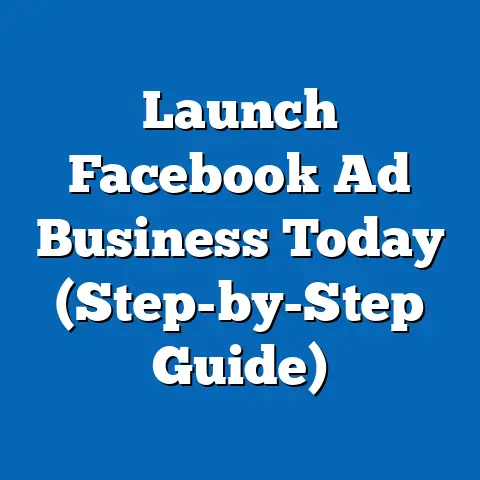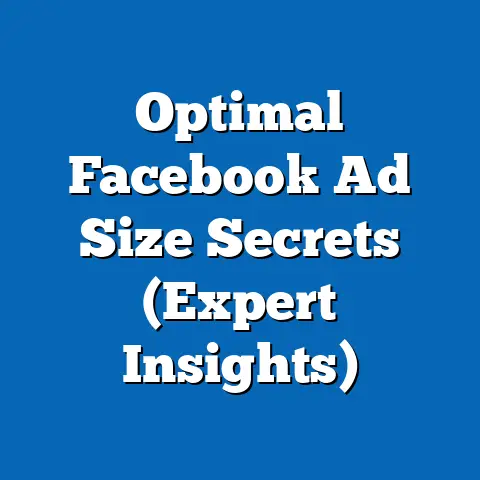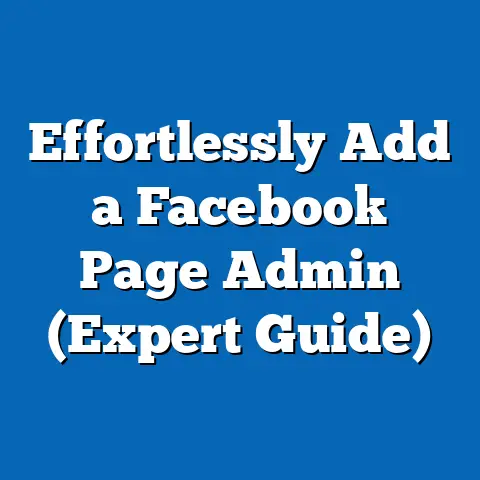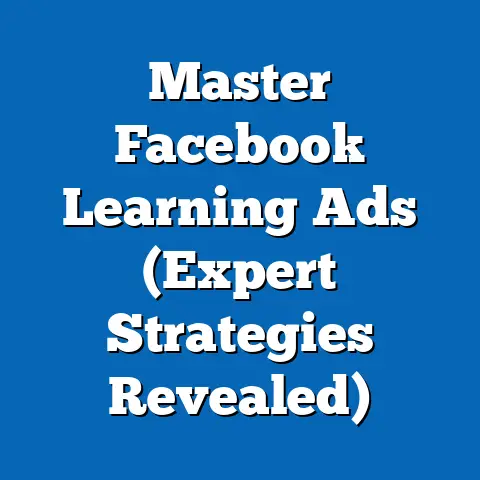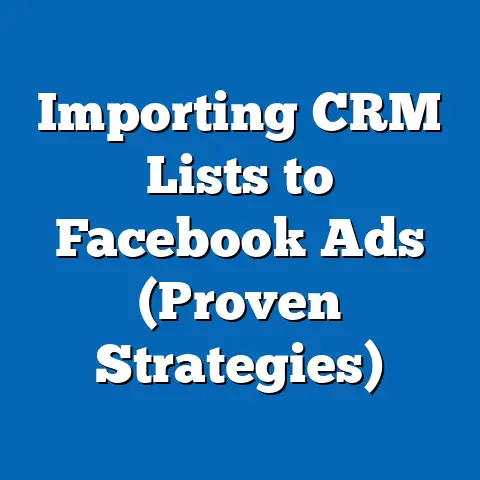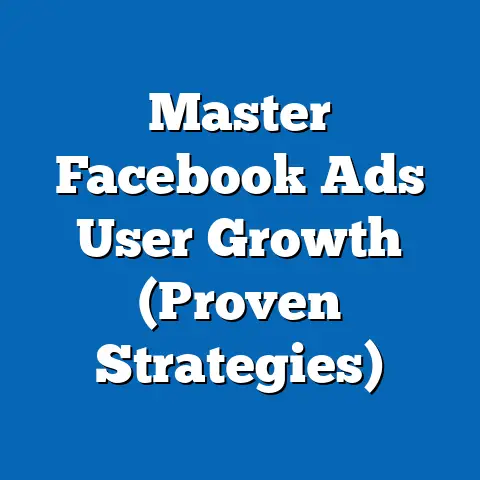Transforming Traditional Ads into Facebook Gold (Pro Tips)
In the ever-evolving world of digital marketing, I’ve witnessed firsthand the struggles businesses face in adapting their traditional advertising strategies to the dynamic realm of social media. Specifically, Facebook presents a unique landscape where user engagement and precise targeting capabilities can make or break a campaign. Traditional advertising methods like print, television, and radio, while not entirely obsolete, often fall short in reaching today’s digitally savvy consumers. I’ve seen countless businesses pour money into traditional campaigns only to see minimal returns, simply because they haven’t adapted their message to the right platform. That’s why it’s crucial for marketers to find innovative ways to transform their traditional ads into Facebook-friendly content that not only grabs attention but also drives real results.
In this article, I’ll share actionable strategies, expert insights, and pro tips gleaned from my own experiences and observations, all aimed at helping you transform your traditional ads into compelling Facebook campaigns that resonate with your target audience.
Section 1: Understanding the Difference Between Traditional and Facebook Advertising
Before diving into the transformation process, it’s essential to understand the fundamental differences between traditional and Facebook advertising.
What is Traditional Advertising?
Traditional advertising encompasses methods like:
- Print Ads: Think newspapers, magazines, brochures, and billboards.
- Television Ads: Commercials broadcast during TV programs.
- Radio Ads: Audio spots aired on radio stations.
- Direct Mail: Physical mail sent to targeted households.
These methods are characterized by:
- One-Way Communication: Primarily a broadcast approach where businesses push messages to a passive audience.
- Limited Targeting: Targeting is generally broad, based on demographics or geographic location.
- Difficult Measurement: Measuring the effectiveness of these campaigns can be challenging and often relies on estimations.
The Unique Features of Facebook Advertising
Facebook advertising offers a completely different paradigm:
- Two-Way Communication: Facebook fosters engagement and interaction between businesses and consumers.
- Granular Targeting: Facebook allows you to target users based on demographics, interests, behaviors, and even custom data.
- Detailed Analytics: Facebook Ads Manager provides comprehensive data on ad performance, allowing you to track key metrics like reach, engagement, and conversions.
- Diverse Ad Formats: From image ads to video ads, carousel ads to lead generation ads, Facebook offers a variety of formats to suit different objectives.
I remember working with a local bakery that had been running print ads in the local newspaper for years. They were seeing declining results and weren’t sure why. When we shifted their focus to Facebook, using targeted ads showcasing their delicious pastries and offering exclusive deals to local residents, their sales skyrocketed. This highlighted the power of Facebook’s precise targeting and interactive nature.
Adapting to the Facebook Platform
The key takeaway here is that simply repurposing a traditional ad for Facebook won’t cut it. You need to adapt your messaging, visuals, and calls-to-action to align with the platform’s unique environment. Facebook users are scrolling through their feeds, looking for engaging content. Your ad needs to be visually appealing, relevant to their interests, and offer a clear value proposition.
Next Steps: Take a moment to reflect on your current advertising efforts. Are you relying solely on traditional methods? Consider how you can start incorporating Facebook into your marketing strategy to leverage its powerful targeting and engagement capabilities.
Section 2: Analyzing Your Traditional Ads for Conversion Potential
Before you can transform your traditional ads into Facebook gold, you need to assess their current state. Not all traditional ads are created equal, and some will have more conversion potential than others.
Step-by-Step Evaluation Guide
Here’s a step-by-step guide to evaluating your existing traditional ads:
- Identify the Core Message: What is the main message you’re trying to convey? Is it clear and concise?
- Assess the Visual Appeal: Is the ad visually appealing and attention-grabbing? Does it use high-quality images or graphics?
- Evaluate the Call-to-Action: Does the ad have a clear call-to-action (CTA)? What do you want the audience to do after seeing the ad?
- Analyze the Emotional Appeal: Does the ad evoke any emotions? Does it tell a story or connect with the audience on a personal level?
- Consider the Target Audience: Who is the intended audience for the ad? Is the messaging relevant to their needs and interests?
Key Elements to Focus On
When evaluating your ads, pay close attention to these key elements:
- Messaging Clarity: Is the message easy to understand at a glance? Avoid jargon or overly technical language.
- Emotional Appeal: Ads that evoke emotions tend to be more memorable and impactful.
- Visual Impact: High-quality visuals are essential for capturing attention in a crowded Facebook feed.
Audience Segmentation
One of the biggest advantages of Facebook advertising is its ability to target specific demographics. Before you start transforming your ads, it’s crucial to understand your target audience on Facebook.
- Demographics: Age, gender, location, education, income, etc.
- Interests: Hobbies, passions, activities, etc.
- Behaviors: Purchase history, online activity, device usage, etc.
I once helped a clothing retailer revamp their traditional print ads for Facebook. Their print ads were targeted at a general audience, but on Facebook, we segmented their audience based on age, interests, and shopping habits. This allowed us to create highly targeted ads that resonated with each segment, resulting in a significant increase in sales.
Next Steps: Gather all your existing traditional ads and go through the evaluation process outlined above. Identify the strengths and weaknesses of each ad, and consider how you can adapt them for different Facebook demographics.
Section 3: Crafting Compelling Facebook Ad Copy
The copy in your Facebook ad is just as important as the visuals. It’s your opportunity to grab the user’s attention, convey your message, and persuade them to take action.
The Art of Engaging Ad Copy
Here are some tips for writing engaging ad copy that speaks to Facebook users:
- Catchy Headlines: Your headline is the first thing people will see, so make it count. Use strong verbs, ask questions, or offer a compelling benefit.
- Relatable Language: Use language that your target audience will understand and relate to. Avoid jargon or overly formal language.
- Concise Messaging: Keep your message brief and to the point. Facebook users are scrolling quickly, so you need to capture their attention in a few seconds.
Incorporating Storytelling Elements
Traditional ads often rely on storytelling to connect with the audience. You can incorporate these elements into your Facebook copy, but keep it brief and engaging.
- Focus on the Problem: Start by identifying a problem that your target audience is facing.
- Offer a Solution: Present your product or service as the solution to that problem.
- Highlight the Benefits: Emphasize the benefits of using your product or service.
I recall working with a local restaurant that had a beautiful TV commercial telling the story of their family-owned business. We adapted this story for Facebook by creating a series of short, engaging video ads that highlighted different aspects of their history and values. This approach resonated with the local community and helped them build a loyal following on Facebook.
Next Steps: Take your existing ad copy and rewrite it with Facebook in mind. Focus on creating catchy headlines, relatable language, and concise messaging. Incorporate storytelling elements where appropriate.
Section 4: Designing Eye-Catching Visuals for Facebook
Visuals are the heart of Facebook advertising. In a sea of content, your visuals need to stand out and grab the user’s attention.
The Role of Visuals
Here’s how visuals in Facebook ads differ from traditional media:
- Mobile-First: Most Facebook users access the platform on their mobile devices. Your visuals need to be optimized for mobile viewing.
- Attention-Grabbing: You have a limited amount of time to capture the user’s attention. Your visuals need to be visually appealing and relevant to their interests.
- Brand Consistency: Your visuals should be consistent with your brand identity.
Pro Tips for Creating Effective Visuals
- Use High-Quality Images: Avoid blurry or pixelated images.
- Use Bright Colors: Bright colors tend to stand out more in the Facebook feed.
- Use Faces: Images with faces tend to be more engaging.
- Use Video: Video ads are highly engaging and can convey a lot of information in a short amount of time.
Mobile Optimization
It’s crucial to ensure that your visuals are effective across all devices, especially mobile.
- Use the Right Dimensions: Facebook recommends specific dimensions for different ad formats.
- Keep Text to a Minimum: Avoid using too much text in your visuals.
- Test Your Visuals: Test your visuals on different devices to ensure they look good.
I once worked with a travel agency that was struggling to get results from their Facebook ads. Their visuals were low-quality and didn’t capture the beauty of the destinations they were promoting. We invested in professional photography and created visually stunning ads that showcased the unique experiences they offered. This resulted in a significant increase in bookings.
Next Steps: Review your existing visuals and make sure they meet the criteria outlined above. Consider investing in professional photography or videography to create high-quality visuals that will stand out in the Facebook feed.
Section 5: Utilizing Facebook’s Targeting Features to Maximize Reach
Facebook’s targeting capabilities are what truly set it apart from traditional advertising. You can reach a highly specific audience based on demographics, interests, behaviors, and more.
Advanced Targeting Options
Here are some of the advanced targeting options available on Facebook:
- Custom Audiences: Target people who have interacted with your business in the past, such as website visitors, email subscribers, or customers.
- Lookalike Audiences: Find new people who are similar to your existing customers.
- Interest-Based Targeting: Target people based on their interests, hobbies, and activities.
Leveraging Targeting Features
Here’s how to leverage these features to reach the right audience for your transformed ads:
- Start with a Clear Understanding of Your Target Audience: Who are you trying to reach? What are their needs and interests?
- Use Custom Audiences to Re-Engage Existing Customers: Target people who have already shown interest in your business.
- Use Lookalike Audiences to Expand Your Reach: Find new customers who are similar to your existing ones.
- Use Interest-Based Targeting to Reach New Audiences: Target people who are interested in your products or services.
Case Studies
I’ve seen countless examples of successful targeting strategies that have led to increased engagement and conversions. For instance, a local fitness studio used custom audiences to target people who had visited their website and offered them a free trial. This resulted in a significant increase in sign-ups.
Next Steps: Take some time to explore Facebook’s targeting options and experiment with different combinations. The more targeted your ads are, the more effective they will be.
Section 6: A/B Testing: Refining Your Facebook Ads for Optimal Performance
A/B testing, also known as split testing, is a crucial process for optimizing your Facebook ad campaigns. It involves creating two versions of an ad with a single variation and testing them against each other to see which performs better.
What is A/B Testing?
A/B testing allows you to make data-driven decisions about your ad campaigns. By testing different elements of your ads, you can identify what resonates best with your target audience and improve your overall performance.
Setting Up A/B Tests
Here’s a guide on how to set up A/B tests for different ad elements:
- Choose a Variable to Test: Select one element of your ad to test, such as the headline, image, or call-to-action.
- Create Two Versions of the Ad: Create two versions of the ad with the variable element changed.
- Set Up Your Test in Facebook Ads Manager: Use Facebook Ads Manager to set up your A/B test.
- Run the Test for a Sufficient Amount of Time: Allow the test to run long enough to gather statistically significant data.
- Analyze the Results: Analyze the results to see which version of the ad performed better.
Analyzing Results
Once your A/B test is complete, it’s time to analyze the results and make data-driven decisions.
- Look at the Key Metrics: Pay attention to metrics like click-through rate (CTR), conversion rate, and cost per acquisition (CPA).
- Identify the Winning Version: Determine which version of the ad performed better based on the key metrics.
- Implement the Winning Version: Implement the winning version of the ad in your campaign.
I once worked with an e-commerce business that was struggling to get conversions from their Facebook ads. We ran A/B tests on different headlines and found that headlines that included a specific discount offer performed significantly better. This simple change resulted in a dramatic increase in sales.
Next Steps: Start incorporating A/B testing into your Facebook advertising strategy. Experiment with different elements of your ads to see what resonates best with your target audience.
Section 7: Measuring Success: Key Metrics to Track
Measuring the success of your Facebook ads is essential for ensuring that you’re getting a return on your investment. By tracking key metrics, you can identify what’s working and what’s not, and make adjustments to your campaigns accordingly.
Essential Metrics to Monitor
Here are some of the essential metrics to monitor for assessing the success of your Facebook ads:
- Reach: The number of people who saw your ad.
- Impressions: The number of times your ad was displayed.
- Click-Through Rate (CTR): The percentage of people who clicked on your ad.
- Conversion Rate: The percentage of people who took a desired action after clicking on your ad (e.g., making a purchase, filling out a form).
- Cost Per Acquisition (CPA): The cost of acquiring a new customer through your Facebook ads.
- Return on Ad Spend (ROAS): The amount of revenue you generate for every dollar you spend on Facebook ads.
Using Facebook Insights and Ads Manager
Facebook Insights and Ads Manager provide a wealth of data that you can use to track your ad performance.
- Facebook Insights: Provides data on your audience demographics, engagement, and reach.
- Facebook Ads Manager: Provides data on your ad performance, including reach, impressions, CTR, conversion rate, and CPA.
Setting Up Tracking Mechanisms and Goals
To ensure continuous improvement, it’s important to set up tracking mechanisms and goals for your Facebook ad campaigns.
- Define Your Goals: What do you want to achieve with your Facebook ads? (e.g., increase brand awareness, generate leads, drive sales)
- Set Up Conversion Tracking: Use Facebook Pixel to track conversions on your website.
- Monitor Your Metrics Regularly: Check your metrics regularly to see how your ads are performing.
I’ve seen businesses transform their Facebook advertising results by simply paying closer attention to their metrics and making data-driven adjustments. One example is a local bookstore that started tracking their conversion rate and realized that their ads were driving traffic to their website but not resulting in sales. They adjusted their ad copy and landing page to better align with their target audience, which led to a significant increase in conversions.
Next Steps: Start tracking your Facebook ad metrics and setting up tracking mechanisms and goals. Use this data to continuously refine your strategies and improve your ad performance.
Conclusion: Embracing Change for Lasting Impact
Transforming traditional ads into Facebook gold requires a willingness to adapt and innovate. I’ve shared actionable strategies, expert insights, and pro tips that I’ve learned through my own experiences. By leveraging the unique features of Facebook, understanding audience behavior, and continuously refining your strategies through testing and analytics, you can create compelling campaigns that not only capture attention but also drive significant results.
Embracing this digital shift is not just an opportunity but a necessity for businesses seeking to thrive in today’s competitive landscape. The world is changing, and your advertising strategies need to change with it. By taking the steps outlined in this article, you can transform your traditional ads into Facebook gold and unlock the full potential of this powerful advertising platform.

